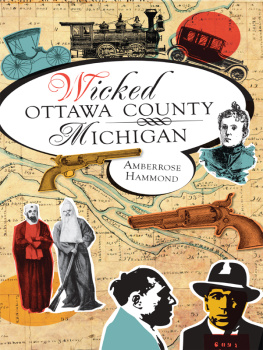INTRODUCTION
We present this history with pleasure, because it deals with a pleasant subject Oakland county. There is another reason for this attitude toward our subject: the cooperation of contributors and of citizens has been so general and hearty that the historical work required has been transformed from a task into a labor of love.
Oakland county is peculiarly fortunate in the variety of her charms and riches, to which truth these pages bear witness. With her landscape beauties and sunny lakes, she is drawing thousands to her who seek restful homes and profitable investments. At the same time, her soil is fertile and invites the practical farmer, dairyman and horticulturist, while in the urban centers, the industrial and commercial interests have obtained a firm foothold and assure livelihood and profit to the citizen. No county in the state has better schools, and, as will be made plain in the progress of this history, in no section has woman had a more extended or elevating influence. In a word, Oakland is unexcelled as a home county; no more need be said to the good American, whether of native or foreign blood.
As to the collaborators on the history, too much cannot be said of the quantity and quality of the assistance rendered by Hon. Aaron Perry. In those homely words which so truly express our feeling toward him "what could we have done without him!" Also as to Miss Martha Baldwin and Mrs. Lilian Drake Avery "what could we have done without them" especially in setting forth the scope of woman's work, and the splendid part taken by the pioneers of the county in laying the foundation upon which the later generations have built their comfort and prosperity. Thanks are rendered all our associate editors Fred M. Warner, Thomas L. Patterson, Harry S. Gardner and Samuel W. Smith, for their willing and effective cooperation. The county and village officials, business men, farmers and manufacturers all, in fact, who have worked to make Oakland county what it is today and are laboring for its greater future have our sincere thanks, both for what they are doing toward the progress of this favored section of the state, and for what they have done in enabling us to picture it in this history of Oakland county. Thaddeus D. Seeley.
CHAPTER I. THE GREAT TRANSFORMATION
The natural features of Oakland county seemed to predestine its material development of the past twenty years or more. Its four hundred and fifty lakes, many of which are thus called only by a generous stretch of the imagination, are thickly sprinkled over its gently rolling surface, while pretty islands stud these little gems of water. As there is a lake to each two square miles of land it is evident that these charming bodies of water had to be reckoned with in the future of the country.
In the early times those who settled in the county had to live, had to eat and be clothed, and they therefore did what pioneers have always done; they turned to the soil, and raised crops and livestock. But as the country developed and became known to outsiders, its attractions as a resort for those seeking rest and recreation, its advantages for those who wished permanent homes with beautiful and comfortable surroundings, became so apparent that there was more and more an insistent demand for land, especially in the vicinity of the lakes which obviously meant that such demand not only became insistent but widespread. Before describing in detail this comparatively lake transformation of Oakland county from an agricultural community to a country of summer and permanent homes, we shall turn in our tracks and note the main features supplied by nature in the bringing about of this change.
Wonderful Country of Lakes
The average number of lakes in each township of Oakland county is eighteen, though Troy, Royal Oak, Southfield, Farmington and Lyon are very deficient in comparison with other sections of the county. The largest of the lakes and the most generously supplied of the townships lie west and southwest of Pontiac. Orion, toward the northeast, is also the center of one of the most important development of resorts and homes in the county, as it is the nucleus of some of its most charming lakes, the largest of which is the body of water which gives the place its name. In the Pontiac group are Cass, Orchard, Elizabeth, Sylvan, and Pine. Walled lake to the southwest, lying in both Commerce and Novi townships, is also one of the larger bodies, all of which are over three hundred and fifty acres in extent. The largest is Cass, covering about twelve hundred acres, or nearly two square miles. It was named after Governor Cass, and lies mostly in West Bloomfield township, with two of its arms extending into Waterford. Its extreme length from southwest to northeast is about two and three quarter miles and its extreme breadth, not measuring its arm, is a trifle over a mile.
Altogether the lakes of Oakland county cover twenty thousand square acres, and the comparative importance of the townships from the standpoint of natural reservoirs is told in the following figures: West Bloomfield has a lake surface of 4,000 square acres; Waterford, of 2,600; Orion, 1,700; Commerce, 1,700; White Lake, 1,300; Highland, 1,200; Bloomfield, 1,200; Addison, 1,000; Holly, 900; Rose, 900; Independence, 800; Brandon, 606; Springfield, 600; Novi, 650; Oxford, 500; Groveland, 250; Oakland, 250; Milford, 160; Lyon, 160; Avon, 30.
Cass and Orchard
Continuing the description of the individual lakes: After Cass comes Orchard lake, in size; perhaps exceeding it in beauty and general interest. It is certainly one of the finest sheets of water in southern Michigan, is circular in form, lies wholly in West Bloomfield township, and, including the islands encompassed by its water, covers about eight hundred and fifty acres. Orchard lake derives its name from the beautiful island of some thirty acres embraced by it, which the Indians called "Me-nah-sagor-ning," or the "place of the orchard." When the United States surveyors and the earliest of the permanent settlers came to this locality, they found quite a number of apple trees still in bearing, supposed to have been planted by French settlers, or at least to have been grown from seeds obtained of them at Detroit. Apple island, as it is now called, is almost in the geographical center of the lake. Northwest of it is the smaller Cedar island.
Both Cass and Orchard lakes are now surrounded by summer cottages and homes, pleasant walks and drives meandering around their shores. One of the most artistically and thoroughly improved of the beautiful shorelands of Cass lake is known as Keego Harbor, while a popular feature counted among the attractions of Orchard lake is the Polish Seminary, founded upon the old-time Orchard Lake Military Academy. The entire chain of little sparkling lakes from Pontiac, southwest to Cass and Orchard Crystal, Sylvan, Lord and Pine presents a succession of cottages, boat landings and summer devices, as well as a display of comfortable, if modest, homes for residents who are justly in love with the sunny and gentle picturesqueness of the country.
The majority of the lakes are drained by Clinton river, although quite a large number in the western and southwestern parts of the county are bound together by the Huron, while some in the northwestern portions find an outlet through the Shiawassee river and thence into Saginaw bay. A few lakes in Bloomfield and West Bloomfield townships are also drained through the Rouge river.










